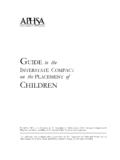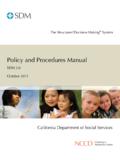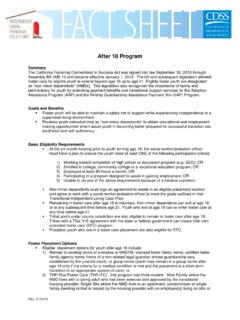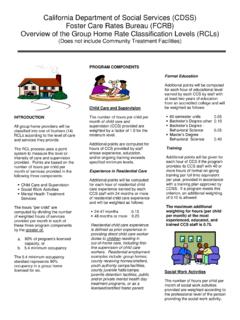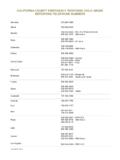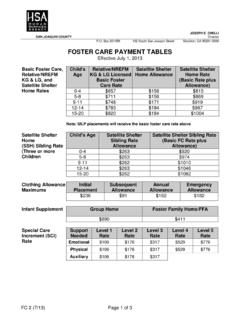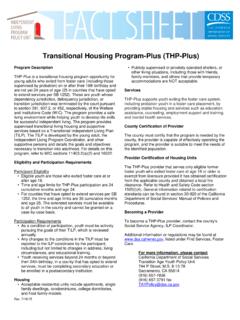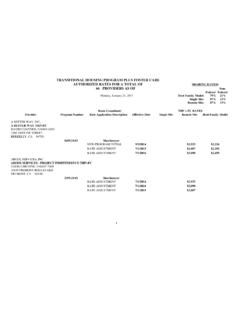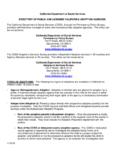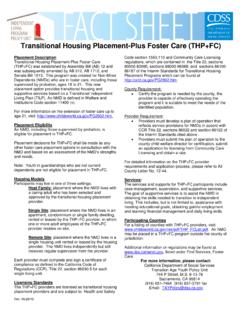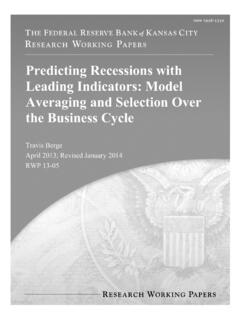Transcription of Northern California Training Academy - Info & Resources
1 Northern California Training Academy predicting and Minimizing the Recurrence of Maltreatment Literature Review PREPARED BY. Ryan D. Honomichl, PhD. &. Susan Brooks, MSW. UC Davis Human Services Northern California Training Academy Funded by the California Department of Social Services August 2009. Northern Training Academy Supporting Children and Family Services 1632 Da Vinci Ct. Davis, CA 95616-4860. Tel: (530) 757-8643 Fax: (530) 752-6910 Email: Northern California Training Academy 2. The Center For Human Services predicting and Minimizing Reabuse August 2009. Table of Contents EXECUTIVE SUMMARY ..4. PURPOSE ..6. INTRODUCTION .. 7. Importance of Studying Recurrence of Maltreatment 7. Prevalence of Recurrent Maltreatment .8. Historical Overview of Child Abuse .9. The Problem of Substantiation ..9. Level of Analysis ..10. Tension between Reunification and Potential for Reabuse .. 11. METHODOLOGY.
2 12. FINDINGS .. 13. Definitions of Types of Maltreatment ..13. General Factors ..13. Child Factors ..14. Parent Factors .15. Family Factors .17. Service Factors .18. Type of Maltreatment and Relationship with Reabuse and Reentry 18. Physical Abuse .18. Sexual Abuse 19. Neglect ..21. Practices and Techniques for Minimizing Recurrence of Abuse and Neglect ..22. Emphasis on Early Intervention ..24. Voluntary Services for Unsubstantiated Cases ..25. Substance Abuse Treatment ..26. Parental Therapeutic Intervention ..26. RECOMMENDATIONS AND FUTURE DIRECTIONS .. 28. REFERENCES ..30. Northern California Training Academy 3. The Center For Human Services predicting and Minimizing Reabuse August 2009. Executive Summary Purpose of this Review The purpose of this literature review is to explore several issues related to foster care and child maltreatment. First, the factors that predict repeated episodes of abuse or neglect are examined.
3 Specifically, the focus is on the conditions and circumstances that facilitate, cause or relate to the potential for child maltreatment to continue following an initial report. Second, factors and practices that may limit the potential for the recurrence of maltreatment are explored. The hope is that the information presented here will help administrators, supervisors and case workers in the child welfare system 1) recognize potential risk factors and strengths that families demonstrate, and 2) utilize this knowledge in the process of permanency planning and case management. Method Literature was reviewed and acquired using the following search databases: Academic Search Premier, PsychINFO, and PsycARTICLES. Additionally, in using the World Wide Web, primarily Google, the following Child Welfare Research and Policy Organization websites were searched: Child Welfare Research Center (CWRC) ( ), Child Welfare Information Gateway ( ) and American Humane Association ( ).
4 These databases were selected to locate peer-reviewed literature. The following search terms were used: reabuse, maltreatment recurrence, repeated maltreatment, revictimization, maltreatment recidivism. Additionally, an iterative process was used in that the results or discussions from one search were used for further searches based on additional references or key words. Northern California Training Academy 4. The Center For Human Services predicting and Minimizing Reabuse August 2009. Discussion and Future Directions Distinct factors at the level of child, parent, family and community were found to be influential in predicting future episodes of abuse and/or neglect. Furthermore, three kinds of maltreatment, physical abuse, sexual abuse and neglect were found to have peculiar treatment issues surrounding each. Finally, several practices and strategies related to lowered recurrence of maltreatment were considered.
5 These practices point to the importance of early intervention, the offering of voluntary services to unsubstantiated cases and the provision of substance abuse treatment as a means of reducing future abuse. However, evidence also points to the limited potential of parent or family therapy in affecting substantive and permanent change. Northern California Training Academy 5. The Center For Human Services predicting and Minimizing Reabuse August 2009. Purpose of this Review This literature review was written to identify factors related to increased potential for reabuse in families that have been reunified. Although the goal of child welfare services is to change the environment in which abused or neglected children are raised, this goal is not always achieved. Factors related to the child, the parents and other circumstances related to the case may contribute to continued abuse and neglect after the child is reunified with family.
6 Identifying these factors and long term stability of reunification is difficult since a consistent set of outcome variables are not evident in the research literature (Barth, 2001). For example, Brooks and MacDonald (2009) suggest that definitions of abuse recurrence are not consistent across many studies. For example, some studies count substantiated abuse events while others count both substantiated and unsubstantiated. Given the ambiguity of this issue in the literature, the present review examines existing studies to finding common factors/variables that are related to increased probability of abuse recurrence following reunification. Furthermore, factors are separated based on three broad categories: physical abuse, sexual abuse and neglect. This is important as each category contains specific problems and conditions that must be considered. A second goal of this review is an examination of practices that have been shown empirically to reduce the risk of reabuse.
7 This was done to provide case workers and supervisors with potential tools for successful and stable case management. Furthermore, a greater understanding of the factors that may lead to reabuse, and the promising practices that circumvent it, serve as tools for service providers in helping children and families after an initial report of abuse or neglect. Northern California Training Academy 6. The Center For Human Services predicting and Minimizing Reabuse August 2009. Introduction Maltreatment of children is a major social welfare problem and public health concern. The long term consequences of maltreatment include poor developmental outcomes for children such as increased risk for anxiety, depression and aggressive behavior (Gilbert et al., 2009). In addition, childhood maltreatment has been linked to higher levels of child and adolescent obesity and sexual risk taking as well poor school performance (Fergusson, Horwood, & Lynskey, 1997; Grilo & Masheb, 2001; Whitaker, Phillips, Orzol & Burdette, 2007).
8 Despite being of great social concern and a topic of sustained research for 40 years, childhood maltreatment is still not a well understood issue (Hussey, Chang, & Kotch, 2006). Issues related to prevalence, physical and psychological consequences and (of most interest to this review) risk factors that predict repeated maltreatment are still in need of more intense empirical study. Furthermore, information regarding techniques and practices for reducing the recurrence of abuse is also limited. In the present review, we examined the existing literature for overarching themes and factors that are related to the potential for repeated maltreatment of children by their parents. In addition, we look at empirically supported practices for minimizing reabuse as well as promising practices that are not yet well supported but may bear empirical fruit in future studies of best practices. Importance of Studying Recurrence of Maltreatment Why study reabuse as a topic of research distinct from abuse or child maltreatment?
9 First, it is important to note that in prospective studies of abuse, the best predictor of whether abuse will occur in the future is whether or not it has occurred in the past. This may seem intuitive or obvious, but considering the number of factors that also predict abuse, such as age, gender, parental poverty or substance abuse, the power of the relationship between episodes of abuse has been found to be fairly strong (Hindley et al., 2006). This leads to the second Northern California Training Academy 7. The Center For Human Services predicting and Minimizing Reabuse August 2009. point. An obvious goal of the Child Welfare System (CWS) is to eliminate future episodes or incidents of abuse or neglect in a family. There may be variables or factors that contribute to continued abuse or neglect that are distinct from those that contributed to an initial incident. For example, in a five year longitudinal study, Levy and colleagues (1995) studied 300 children who had endured documented cases of abuse.
10 As a result of this effort, the authors came to the conclusion that the factors that predict initial abuse are not the same as those that predict reabuse. Workers in the Child Welfare System should be aware of the different factors that characterize risk for repeated maltreatment. Prevalence of Recurrent Maltreatment How common is recurrence of abuse or neglect? Though evidence is limited, estimates range from 9 to 66% (Butterfield, Jackson, & Nangle, 1979; Fryer & Miyoshi, 1996), with an average reported percentage of between 20 30% (Courtney, 1995; Goerge, 1990; Murphy, Bishop, Jellinick, Quinn, & Poitrast, 1992; Wulczyn, 1991). As can be ascertained from the large range in the estimated prevalence of the recurrence of maltreatment, these data are not without problems. First, many studies of reabuse are based on small samples that are not representative of a larger population. This has led to variation in findings from one study to the next, making it difficult to ascertain a clear picture.
